英语人教版七年级上册可数名词单数变复数的规律
- 格式:ppt
- 大小:305.00 KB
- 文档页数:5
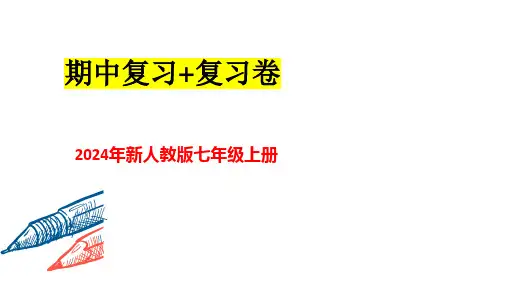
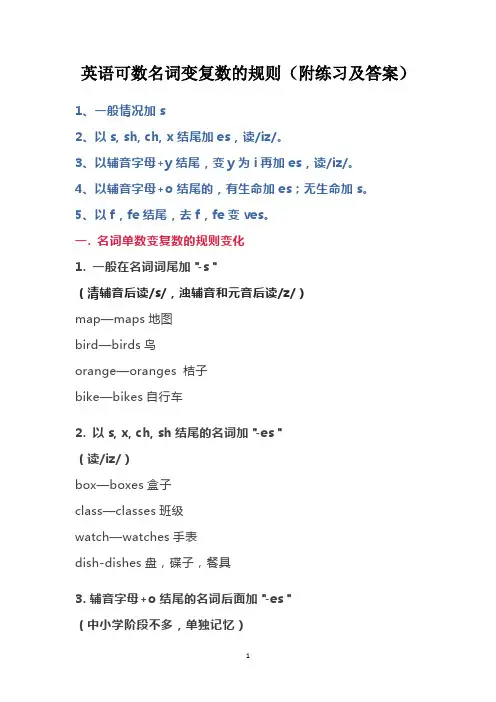
英语可数名词变复数的规则(附练习及答案)1、一般情况加s2、以s, sh, ch, x结尾加es,读/iz/。
3、以辅音字母+y结尾,变y为i再加es,读/iz/。
4、以辅音字母+o结尾的,有生命加es;无生命加s。
5、以f,fe结尾,去f,fe变ves。
一. 名词单数变复数的规则变化1. 一般在名词词尾加"-s"(清辅音后读/s/,浊辅音和元音后读/z/)map—maps地图bird—birds鸟orange—oranges 桔子bike—bikes自行车2. 以s, x, ch, sh结尾的名词加"-es"(读/iz/)box—boxes盒子class—classes班级watch—watches手表dish-dishes盘,碟子,餐具3. 辅音字母+o结尾的名词后面加"-es"(中小学阶段不多,单独记忆)tomato—tomatoes西红柿potato—potatoes土豆hero—heroes英雄negro—negroes黑人辅音字母+o结尾的名词后面加"-s"(一般为外来词或者缩写词)photo—photos相片kilo—kilos千克元音字母+o结尾的名词后面加"s" radio—radios收音机zoo—zoos动物园4. 以辅音字母加y结尾的名词,变y为i加"-es " baby—babies婴儿family—families家庭party—parties聚会以元音字母加y结尾的名词直接加"-s" boy—boys男孩toy—toys 玩具5. 以fe或f结尾的名词,把fe或f变为v加"-es"(读/vz/,数量不多,单独记忆)knife—knives小刀wife—wives妻子leaf—leaves树叶直接加-sroof—roofs房顶proof—proofs证据chief—chiefs首领两种都可以handkechief手绢—handkerchiefs / handkerchieves二. 名词单数变复数的不规则变化1. child—children 孩子foot—feet 脚tooth—teeth 牙齿mouse—mice 老鼠man—men 男人woman—women 女人注意:与man 和woman构成的合成词,其复数形式也是-men 和-women,例如:an Englishman—two Englishmen 但German不是合成词,故复数形式为Germans;Bowman是姓,其复数是the Bowmans(鲍曼一家)。
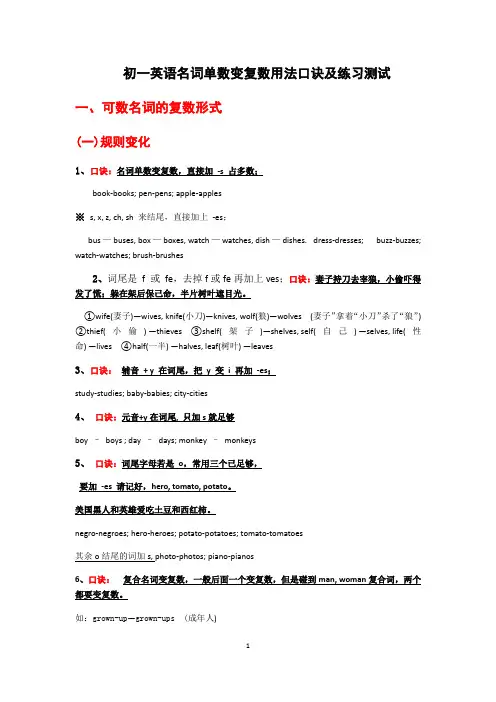
初一英语名词单数变复数用法口诀及练习测试一、可数名词的复数形式(一)规则变化1、口诀:名词单数变复数,直接加-s 占多数;book-books; pen-pens; apple-apples※s, x, z, ch, sh 来结尾,直接加上-es;bus—buses,box—boxes,watch—watches,dish—dishes. dress-dresses; buzz-buzzes; watch-watches; brush-brushes2、词尾是f 或fe,去掉f或fe再加上ves;口诀:妻子持刀去宰狼,小偷吓得发了慌;躲在架后保己命,半片树叶遮目光。
①wife(妻子)—wives,knife(小刀)—knives,wolf(狼)—wolves(妻子”拿着“小刀”杀了“狼”)②thief(小偷)—thieves③shelf(架子)—shelves,self(自己)—selves,life(性命)—lives④half(一半)—halves,leaf(树叶)—leaves3、口诀:辅音+ y 在词尾,把y 变i 再加-es;study-studies; baby-babies; city-cities4、口诀:元音+y在词尾, 只加s就足够boy –boys ; day –days; monkey –monkeys5、口诀:词尾字母若是o,常用三个已足够,要加-es 请记好,hero, tomato, potato。
美国黑人和英雄爱吃土豆和西红柿。
negro-negroes; hero-heroes; potato-potatoes; tomato-tomatoes其余o结尾的词加s, photo-photos; piano-pianos6、口诀:复合名词变复数,一般后面一个变复数,但是碰到man,woman复合词,两个都要变复数。
如:grown-up—grown-ups (成年人)man doctor—men doctors (男医生)(二) 不规则变化男人女人a 变e,鹅足牙oo 变ee;man-men; woman-women; goose-geese; foot-feet; tooth-teeth老鼠虱子也好记,ous 变ic;mouse-mice; louse-lice孩子加上ren,鱼鹿绵羊不用变child-children; fish; deer; sheepthis---these(这些)I --- we it/he/she--- they that -- those(那些)【说明】①man(男人)—men,woman(女人)—women,含有man,woman的合成词,其复数是把a变成e.如:policewoman, postman, f isherman等。
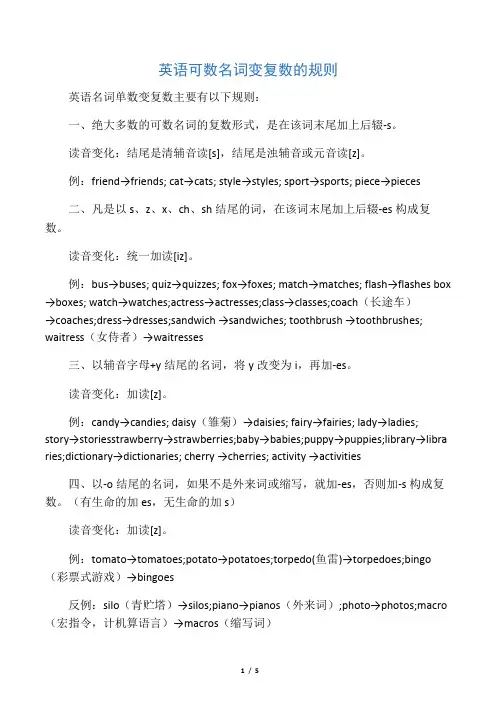
英语可数名词变复数的规则英语名词单数变复数主要有以下规则:一、绝大多数的可数名词的复数形式,是在该词末尾加上后辍-s。
读音变化:结尾是清辅音读[s],结尾是浊辅音或元音读[z]。
例:friend→friends; cat→cats; style→styles; sport→sports; piece→pieces二、凡是以s、z、x、ch、sh结尾的词,在该词末尾加上后辍-es构成复数。
读音变化:统一加读[iz]。
例:bus→buses; quiz→quizzes; fox→foxes; match→matches; flash→flashes box →boxes; watch→watches;actress→actresses;class→classes;coach(长途车)→coaches;dress→dresses;sandwich →sandwiches; toothbrush →toothbrush es; waitress(女侍者)→waitresses三、以辅音字母+y结尾的名词,将y改变为i,再加-es。
读音变化:加读[z]。
例:candy→candies; daisy(雏菊)→daisies; fairy→fairies; lady→ladies;story→storiesstrawberry→strawberries;baby→babies;puppy→puppies;library→libra ries;dictionary→dictionaries; cherry →cherries; activity →activities四、以-o结尾的名词,如果不是外来词或缩写,就加-es,否则加-s构成复数。
(有生命的加es,无生命的加s)读音变化:加读[z]。
例:tomato→tomatoes;potato→potatoes;torpedo(鱼雷)→torpedoes;bingo (彩票式游戏)→bingoes反例:silo(青贮塔)→silos;piano→pianos(外来词);photo→photos;macro (宏指令,计机算语言)→macros(缩写词)五、以-f或-fe结尾的名词,多为将-f或-fe改变为-ves,但有例外。
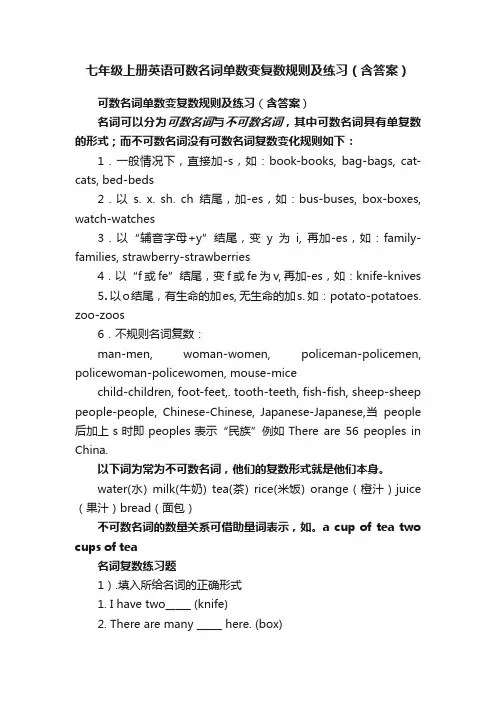
七年级上册英语可数名词单数变复数规则及练习(含答案)可数名词单数变复数规则及练习(含答案)名词可以分为可数名词与不可数名词,其中可数名词具有单复数的形式;而不可数名词没有可数名词复数变化规则如下:1.一般情况下,直接加-s,如:book-books, bag-bags, cat-cats, bed-beds2.以s. x. sh. ch结尾,加-es,如:bus-buses, box-boxes, watch-watches3.以“辅音字母+y”结尾,变y为i, 再加-es,如:family-families, strawberry-strawberries4.以“f或fe”结尾,变f或fe为v, 再加-es,如:knife-knives5.以o结尾,有生命的加es, 无生命的加s. 如:potato-potatoes. zoo-zoos6.不规则名词复数:man-men, woman-women, policeman-policemen, policewoman-policewomen, mouse-micechild-children, foot-feet,. tooth-teeth, fish-fish, sheep-sheep people-people, Chinese-Chinese, Japanese-Japanese,当people 后加上s时即peoples表示“民族”例如There are 56 peoples in China.以下词为常为不可数名词,他们的复数形式就是他们本身。
water(水) milk(牛奶) tea(茶) rice(米饭) orange(橙汁)juice (果汁)bread(面包)不可数名词的数量关系可借助量词表示,如。
a cup of tea two cups of tea名词复数练习题1).填入所给名词的正确形式1. I have two_____ (knife)2. There are many _____ here. (box)3. There are many _____ on the road. (bus)4. A few ____boys_ are drawing on the wall. (boy)5. The _childen____ are playing football now. (child)2)选择填空1. They come from different ______A. countryB. countriesC. a countryD. countrys2. How many ______ do you see in the picture?A. tomatosB. tomatoesC. tomatoD. the tomato3. There are some ______ in these _______.A.knifes…pencil-boxesB.knives…pencils-boxC.knives…pencil-boxD.knives…pencils-boxes4. There is no ______ in the plate.A. applesB. orangesC. riceD. eggs5. _______ are good for our health.A. TomatosB. TomatoesC. Tomato6. I like to eat cake with ______.A. cherriesB. cherryC.cherrys7. ______ and ______ are not friends.A. Foxs…wolfsB.Foxes wolfsC.Foxes…wolves8. Do you want to drink much ?A.a milkkks9. This is room. It’s very bi g.A.Lily and Lucy’sB.Lily’s and Lucy’sC.Lily’s and Lucy10. Do you want some for supper?A、a potatoB、potatoesC、potatos11. In autumn,you can see a lot of on the ground.A、leafB、leafsC、leaves12. My sister has two . One is old,the other is new.A、a watchB、watchsC、watches13.There on the wall .They are very beautiful.A. are photoesB. are photosC. is a photoD. is photos14. That’a art book.A. anB. aC. the D are15. There two in the box.A. is watchB. are watchesC. are watchD. is watches3)请用括号中名词的复数形式填空1. Look at those _______. (child)2. I can see a __________ standing near the door. (policeman) 3. Do you want some ________ for dinner? (potato)4.In autumn, you can see a lot of _______ on the ground.(leaf)5. He has two _______.One is blue , the other is yellow.( box) 6. Two ________ live in this building .( family )4)选择正确的词形1. How many (radioes, radios) can you see?2. There are 36 (boys, boies) in my class.3. Look at those (sheeps, sheep).4.I don’t want (a, an) old cup.5. Give me that (box, boxes), please.5)将以下单复数句进行转换1. This is a knife.___________________________________2. That is a tomato.___________________________________3. That child is very good.___________________________________4 .These are mice.___________________________________5. Those are children.___________________________________答案1.knives boxes buses boys children2.BBDCB ACBAB CCBAB3.Children policeman potatoes leaves boxes families4.Radios boys sheep an5.These are knives.Those are tomatoes.Those children are very good.This is rice.That is child.。
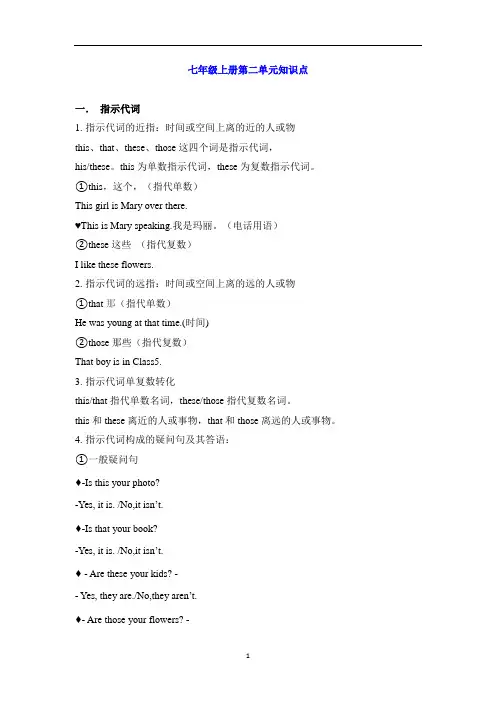
七年级上册第二单元知识点一.指示代词1.指示代词的近指:时间或空间上离的近的人或物this、that、these、those这四个词是指示代词,his/these。
this为单数指示代词,these为复数指示代词。
①this,这个,(指代单数)This girl is Mary over there.♥This is Mary speaking.我是玛丽。
(电话用语)②these这些(指代复数)I like these flowers.2.指示代词的远指:时间或空间上离的远的人或物①that那(指代单数)He was young at that time.(时间)②those那些(指代复数)That boy is in Class5.3.指示代词单复数转化this/that指代单数名词,these/those指代复数名词。
this和these离近的人或事物,that和those离远的人或事物。
4.指示代词构成的疑问句及其答语:①一般疑问句♦-Is this your photo?-Yes, it is. /No,it isn’t.♦-Is that your book?-Yes, it is. /No,it isn’t.♦ - Are these your kids? -- Yes, they are./No,they aren’t.♦- Are those your flowers? -- Yes, they are./No,they aren’t.②特殊疑问句♦- Who is this?- It's my dad.- Who is this?- It's my dad.♦-Who’s that?-This is Bob speaking.二.Who1.Who pron.谁,特殊疑问词Whom宾格Whose所有格2.Who 与be 缩写Who is=who’sWho are=who are3.who特殊疑问句3.1单数-Who’s she?-She is my sister.3.2复数-Who’re they?-They are my parents.三.名词复数1. 名词的分类名词分为可数名词不可数名词。
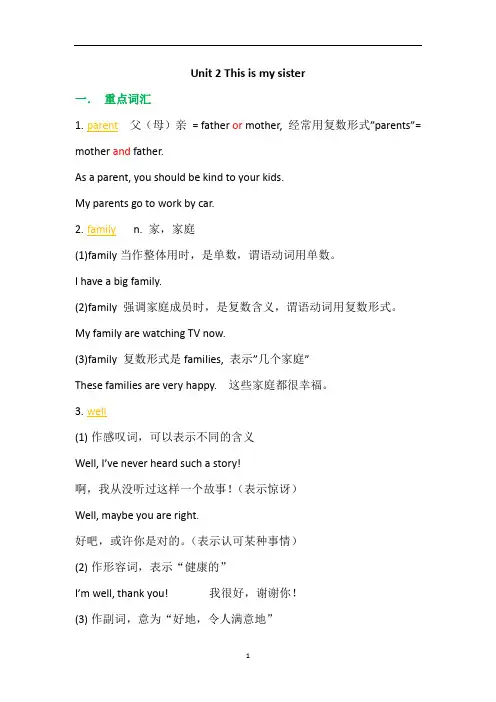
Unit 2 This is my sister一.重点词汇1.parent父(母)亲= father or mother, 经常用复数形式”parents”= mother and father.As a parent, you should be kind to your kids.My parents go to work by car.2.family n. 家,家庭(1)family当作整体用时,是单数,谓语动词用单数。
I have a big family.(2)family 强调家庭成员时,是复数含义,谓语动词用复数形式。
My family are watching TV now.(3)family 复数形式是families, 表示”几个家庭”These families are very happy. 这些家庭都很幸福。
3.well(1)作感叹词,可以表示不同的含义Well, I’ve never heard such a story!啊,我从没听过这样一个故事!(表示惊讶)Well, maybe you are right.好吧,或许你是对的。
(表示认可某种事情)(2)作形容词,表示“健康的”I’m well, thank you! 我很好,谢谢你!(3)作副词,意为“好地,令人满意地”He plays tennis very well. 他网球打得非常好。
4.Have a good time!=Have a good day!(祝福语)玩的开心,过得愉快。
对have a good time 的回答通常为:You, too./Thank you, you too!5.photo照片复数:photos短语:a photo of...意为“一张...的照片”Here is a photo of my family.拓展:a photo of.../photos of...是名词所有格形式,相当于one’s photo(s)。

![英语中名词单数变复数单三的变换总结[1]](https://uimg.taocdn.com/7e0da800240c844768eaee39.webp)
名词复数形式的读音分中情况:1.在轻辅音后面读【S】;2.在浊辅音和元音后面读【Z];3.在t,d的后面分别读【ts】,【dz];4.在s,z,sh,ch,ge等后面一般读作【iz】。
规则动词后加-ed的读音情况如下:1。
在轻辅音后面读【t】;2.在浊辅音和元音后面读【d];3.在t,d的后面分别读【id】;名词变复数,动词第三人称,过去式读音张东启无论是名词变复数、动词第三人称单数形式,还是动词加“ed”的过去式,总的发音规律就是“清清浊浊元也浊”,就是在清辅音后读清辅音,在浊辅音后读浊辅音,在元音后也读浊辅音。
动词第三人称单数词尾变化有三种形式。
(1)一般动词在词尾加-s,-s在清辅音后读/s/,在浊辅音或元音后读/z /,ds读/dz/,ts读/ts/。
如:help→helps/helps/,know→knows/nEuz/,get→gets/gets/,read →reads/ri:dz/(2)以字母s,x,ch,sh或有些以o结尾的动词加-es,-es读/iz/。
如:guess→guesses/'gAsiz/,fix→fixes/'fiksiz/,teach→teaches/'ti:tFiz/,wash→washes/'wRFiz/注意:go→goes/gəuz/,do→does/dΛz/(3)以辅音字母+y结尾的动词,先变y为i,再加-es,-ies读/iz/。
如:carry→carries/'kæriz/,fly→flies/flaiz/注:在play→plays/pleiz/,say→says/sez/中,字母y前为元音字母,第三人称单数形式直接在动词后面加-s。
(4)特殊词例外。
如:be→is,have→has动词过去式和过去分成过去式的发音是由单词的最后一个音素来决定的:1.如果该单词以清辅音结尾,如/k/,/p/等,则读作/t/,例如looked读作/t/.2.如果该单词以浊辅音结尾,如/n/,/b/等,则读作/d/,例如abandoned读作/d/.3.如果该单词以字母t或字母d结尾,则读作/id/,例如started读作/id/.4.如果该单词以元音结尾,则读作/d/,例如studied读作/d/.以上是过去式读音的一般规则,英语中还有许多不规则的动词,他们的过去式及发音就得靠你去记忆了,如buy过去式为bought,等等名词复数的构成和读音可数名词有单数(Singular Form)和复数(Plural Form)两种形式。
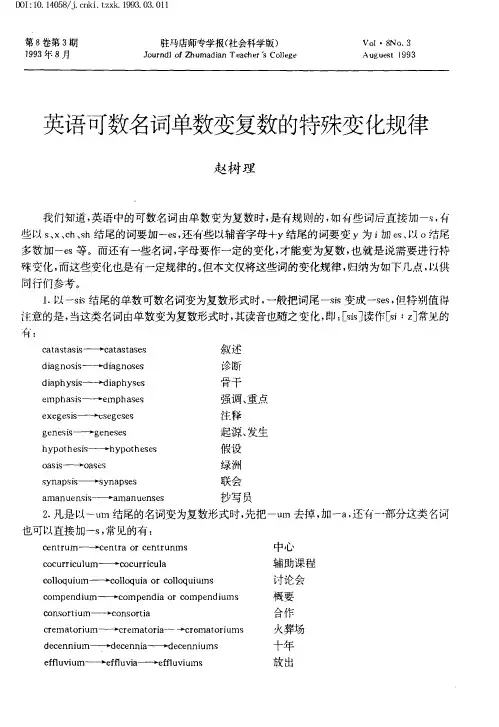
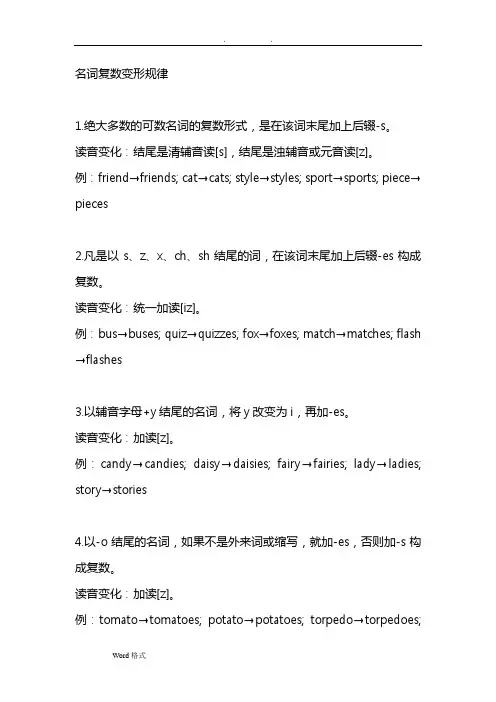
名词复数变形规律1.绝大多数的可数名词的复数形式,是在该词末尾加上后辍-s。
读音变化:结尾是清辅音读[s],结尾是浊辅音或元音读[z]。
例:friend→friends; cat→cats; style→styles; sport→sports; piece→pieces2.凡是以s、z、x、ch、sh结尾的词,在该词末尾加上后辍-es构成复数。
读音变化:统一加读[iz]。
例:bus→buses; quiz→quizzes; fox→foxes; match→matches; flash →flashes3.以辅音字母+y结尾的名词,将y改变为i,再加-es。
读音变化:加读[z]。
例:candy→candies; daisy→daisies; fairy→fairies; lady→ladies; story→stories4.以-o结尾的名词,如果不是外来词或缩写,就加-es,否则加-s构成复数。
读音变化:加读[z]。
例:tomato→tomatoes; potato→potatoes; torpedo→torpedoes;bingo→bingoes反例:silo→silos; piano→pianos(外来词); photo→photos; macro→macros(缩写词)5.以-f或-fe结尾的名词,多为将-f或-fe改变为-ves,但有例外。
读音变化:尾音[f]改读[vz]。
例:knife→knives; life→lives; leaf→leaves; staff→staves; scarf→scarves反例:roof→roofs6.以-us结尾的名词(多为外来词),通常将-us改变为-i构成复数。
读音变化:尾音[Es]改读[ai],其中[kEs]要改读为[sai],[gEs]要改读为[dVai]。
例:fungus→fungi; abacus→abaci; focus→foci; cactus→cacti; cestus→cesti籽伽21:53:097.以-is结尾的名词,通常将-is改变为-es。
人教版七年级英语上册语法大全一、名词(Nouns)名词是指人、物、地点、动物和概念等的名称。
名词可以分为可数名词和不可数名词。
1. 可数名词(Classifiable Nouns):可数名词可以用数字进行计数,并且可以有单数和复数形式。
如:book(书),apple(苹果),dog(狗),student(学生)等。
2. 不可数名词(Uncountable Nouns):不可数名词不可以用数字进行计数,只有单数形式。
如:water (水),music(音乐),money(钱)等。
二、冠词(ARTICLES)冠词是用于修饰名词的词语,在英语中主要有三种冠词:定冠词、不定冠词和零冠词。
1. 定冠词(The Definite Article):定冠词是指特指某个人或物的冠词,只有一个形式,即 "the"。
如:the book(这本书),the cat(这只猫)等。
2. 不定冠词(The Indefinite Article):不定冠词是指泛指人或物的冠词,有两个形式,即"a" 和"an"。
如:a book(一本书),an apple(一个苹果)等。
3. 零冠词(Zero Article):零冠词是指名词前没有任何冠词修饰的情况,也可以表示泛指。
如:I like flowers(我喜欢花)。
三、形容词(Adjectives)形容词是用来描述或修饰名词的词语,通常位于名词前面。
形容词可以分为具体形容词和抽象形容词。
1. 具体形容词(Concrete Adjectives):具体形容词用来描述或修饰可以通过感官观察得到的名词。
如:red (红色的),big(大的),beautiful(美丽的)等。
2. 抽象形容词(Abstract Adjectives):抽象形容词用来描述或修饰无法通过感官观察得到的名词,表示情感、状态或性质等。
如:happy(快乐的),difficult(困难的),interesting(有趣的)等。
第f或fe结尾的名词可数名词的单复数变化规律1.前言英语名词的单复数变化是语法学习中一个重要的部分。
对于以"f"或"f e"结尾的名词,它们在变化为复数形式时存在一些特殊规律。
本文将详细介绍这些特殊规律以及相应的变化规律。
2.以"f"结尾的名词以"f"结尾的名词,其复数形式的变化规律如下:-单数名词末尾的"f"变为"v",再加上"e s"。
-单数:le af(叶子)-复数:le av es(叶子)-以"f"结尾的名词有以下例外,它们的复数形式直接在末尾加上"s"。
-单数:ro of(屋顶)-复数:ro of s(屋顶)-一些以"f"结尾的名词具有相同的单数和复数形式。
-单数和复数均为:c h ie f(首领)-注意:一些以"f"结尾的名词是外来词,它们的复数形式遵循原词语言的规则。
-单数:ki lo(公斤)-复数:ki lo s(公斤)3.以"f e"结尾的名词以"fe"结尾的名词,其复数形式的变化规律如下:-单数名词末尾的"fe"变为"v es"。
-单数:wi fe(妻子)-复数:wi ve s(妻子)-一些以"f e"结尾的名词,将"f e"变为"f"再加上"s"。
-单数:kn if e(刀子)-复数:kn iv es(刀子)-一些以"f e"结尾的名词,其复数形式直接在末尾加上"s"。
-单数:sa fe(保险箱)-复数:sa fe s(保险箱)4.结论以"f"或"fe"结尾的名词,在变为复数形式时存在一些特殊规律。
英语可数名词变复数的规则英语名词单数变复数主要有以下规则:一、绝大多数的可数名词的复数形式,是在该词末尾加上后辍-s。
读音变化:结尾是清辅音读[s],结尾是浊辅音或元音读[z]。
例:friend→friends; cat→cats; style→styles; sport→sports; piece→pieces二、凡是以s、z、x、ch、sh结尾的词,在该词末尾加上后辍-es构成复数。
读音变化:统一加读[iz]。
例:bus→buses; quiz→quizzes; fox→foxes; match→matches; flash→flashes box →boxes; watch →watches; actress →actresses; class →classes; coach(长途车)→coaches; dress →dresses; sandwich →sandwiches; toothbrush →toothbrushes; waitress(女侍者)→waitresses三、以辅音字母+y结尾的名词,将y改变为i,再加-es。
读音变化:加读[z]。
例:ca ndy→candies; daisy(雏菊)→daisies; fairy→fairies; lady→ladies; story→stories strawberry →strawberries; baby →babies; puppy →puppies; library →libraries; dictionary →dictionaries; cherry →cherries; activity →activities四、以-o结尾的名词,如果不是外来词或缩写,就加-es,否则加-s构成复数。
(有生命的加es,无生命的加s)读音变化:加读[z]。
例:tomato→tomatoes; potato→potatoes; torpedo(鱼雷)→torpedoes; bingo(彩票式游戏)→bingoes反例:silo(青贮塔)→silos; piano→pianos(外来词); photo→photos; macro(宏指令,计机算语言)→macros(缩写词)五、以-f或-fe结尾的名词,多为将-f或-fe改变为-ves,但有例外。
人教新目标英语七年级上册名词单复数名词:包括可数名词(如:pear ,tomato ,banana, carrot )和不可数名词(如:drink, beef, chicken, meat, coffee)修饰词:可数名词单数做主语时:可数名词复数做主语时:可数名词单数变复数规则:可数名词练习题:1.I want to buy some____________(tomato).2.There are two____________(potato)on the table.3.Eating too many______________(vegetable)is good for us.4.Milk and fish are good for your__________(tooth).6.The rabbit love to eat___________(胡萝卜)7.Please give me a kilo of__________(牛肉)8.There is __________(一个)onion in the bag.9.Don’t eat too much_________(盐).10.Too much____________(糖)isn’t good for your health.11.I like to eat________(fish).12.There are some________(fish)in the river.13.We haven’t got_____________noodles.A.a B.some C.any D.Much【答案】1.tomatoes 2.potatoes 3.vegetables 4.teeth 5.are 6.carrots 7.beef 8. an 9. salt 10. sugar 11. fish 12. fishes 13. C知识点二:不可数名词修饰词不可数名词做主语时不可数名词1.be动词用is,The beef is great.My water is in the bottle.2.行为动词用三单。